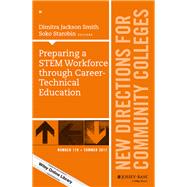
Note: Supplemental materials are not guaranteed with Rental or Used book purchases.
Purchase Benefits
Looking to rent a book? Rent Preparing a STEM Workforce through Career-Technical Education New Directions for Community Colleges, Number 178 [ISBN: 9781119428336] for the semester, quarter, and short term or search our site for other textbooks by Smith, Dimitra Jackson; Starobin, Soko. Renting a textbook can save you up to 90% from the cost of buying.
Soko Starobin is an education consultant/evaluator.
EDITORS’ NOTES 5
Dimitra Jackson Smith, Soko Starobin
Introduces the issue theme of science, technology, engineering, and mathematics (STEM) education, preparation, and career exploration and the role of career and technical education in preparing individuals for the STEM workforce.
1. Community College Pathways to the STEM Workforce: What Are They, Who Follows Them, and How? 9
Michelle Van Noy, Matthew Zeidenberg
Chapter 1 provides a landscape of community college pathways, characteristics of science, technology, engineering, and mathematics (STEM) students, and innovative approaches to curriculum, pedagogy, and course development and delivery for students in STEM programs.
2. A Researcher–Practitioner Partnership on Remedial Math Contextualization in Career and Technical Education Programs 23
Xueli Wang, Yan Wang, Amy Prevost
Chapter 2 highlights the essential nature of the role of partnerships in contextualized math course offerings at a large urban 2-year technical college.
3. An Evolving Entrepreneurship Simulation as a Vehicle for Career and Technical Education 35
Edgar E. Troudt, Stuart A. Schulman, Christoph Winkler
Chapter 3 provides insight into entrepreneurial simulation as a vehicle for career and technical education.
4. How Community Colleges Are Closing the Skills Gap Through CTE and STEM Funding Innovations 45
Kimberly Lowry, Tricia Thomas-Anderson
Chapter 4 discusses the role of funding in 2-year and 4-year institutions and highlight promising funding avenues to improve community college student success, performance, and graduation rates.
5. The Case for Evaluating Student Outcomes and Equity Gaps to Improve Pathways and Programs of Study 55
Debra D. Bragg
Chapter 5 highlights the importance of program evaluation in CTE and STEM pathways and programs for underserved student populations, with a particular focus on Pathways to Results, which began in Illinois.
6. Unwelcoming Classroom Climates: The Role of Gender Microaggressions in CTE 67
Jaime Lester, Brice Struthers, Aoi Yamanaka
Chapter 6 discusses gender inequities in CTE classrooms as well as faculty–student interactions and the overall landscape of genderrelated nuances in CTE courses via an ethnographic case study.
7. Recruiting and Retaining Women in Information Technology Programs (Practices and Challenges in Iowa Community Colleges) 79
Yu (April) Chen, Arlene de la Mora, Mari Kemis
Chapter 7 highlights the challenges and exemplary practices related to recruiting and retaining women in IT.
8. Implications for Policy and Practice: Summary of the Volume and Lessons for the Future of CTE Programs and STEM 91
Dimitra Jackson Smith
Chapter 8 concludes with a summary of the aforementioned chapters, implications for policy and practice, and lessons for the future related to CTE programs and STEM education.
INDEX 97
The New copy of this book will include any supplemental materials advertised. Please check the title of the book to determine if it should include any access cards, study guides, lab manuals, CDs, etc.
The Used, Rental and eBook copies of this book are not guaranteed to include any supplemental materials. Typically, only the book itself is included. This is true even if the title states it includes any access cards, study guides, lab manuals, CDs, etc.